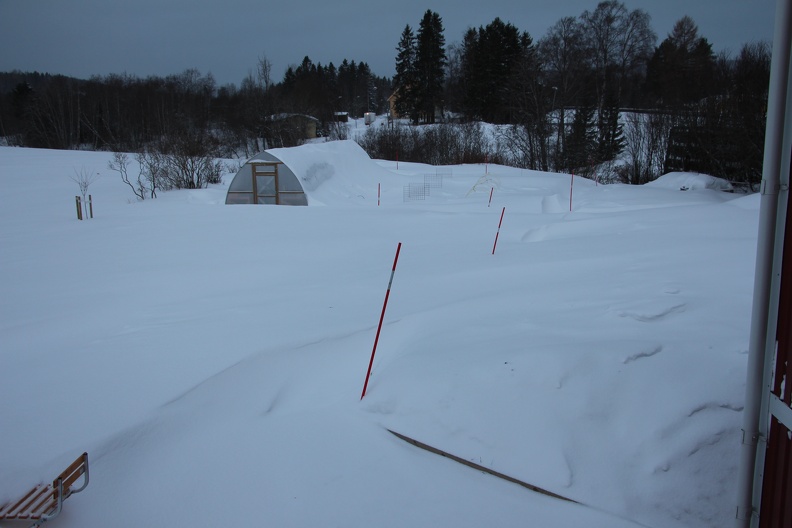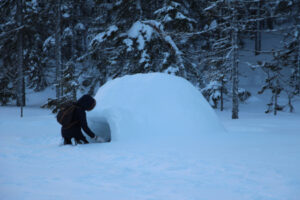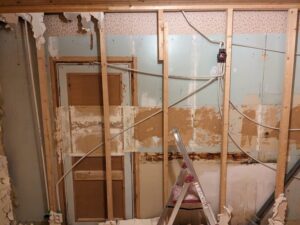2024-01 -30C!
Although January is always cold, it got really cold outside for two days with -30C for about 2-3 days. It’s not a great problem as long as you have the right clothes, but it put some stress on our heating system that I hadn’t prepared for.
The wind also picked up and the path we had cleared got buried under the blown snow.

Ground Source Heat Pump
We used a lot of power due to the cold temperatures. We have a ground source heat pump (GSHP) which is great, but our installation uses a horizontal heat loop. This is a shallow loop buried in a field that is good for summer and autumn but can be less efficient in prolonged winter. During the especially cold weather, the GSHP couldn’t extract enough heat via the heat loop. As a result, it switched to using an electrical element and power from the grid. On the worst day we used 114kWh on one day, and in 8 days we used over 10% of the previous years total electrical usage.
New Rule: Don’t mess with the heating in Winter
I spoke to a local friend about how the house had slowly been losing about 0.8-1.0C a day during the -30C temperature. He advised me on changing the curve that dictates the assistance behaviour of the GSHP in drawing electric from the grid.
Separately, the electric company had put the hourly rate 6 times as high as normal for an hour in the evening, so I set the heating system to not do much work during that time, attempting to be economical.
In hindsight, I should have included bleeding the radiators in winter preparations. I also should have left the heating settings alone and let it do its thing. My actions meant the house got colder, and then later in the evening the heating system tried to aggressively bring the heat back up. This extra effort resulted in pulling increasing amounts of electric from the grid.
Blowing a fuse
I woke up at 04:00 with the feeling that the house was colder than it should be. Getting up and going to see what was wrong, I noticed some house lights worked and others did not. The thermometer on the stairwell read 14C as I went past which meant something was wrong with the heating. Down in the basement I found the GSHP warning me that one of the electrical phases was missing. It uses 3 phases so it couldn’t pull enough power.
Troubleshooting
An important cultural difference is that in the UK the homeowner would only be allowed to touch main circuit board (domestic consumer unit). The fuse upstream of a UK electric meter is the electrical companies’ property. The feed is single phase and typically 100amp. The house owner would never normally blow the fuse as a circuit breaker would trip first. Until 2022 even electricians would potentially get in trouble for touching the main fuse.
So in Sweden, I went to the main circuit breaker board (domestic consumer unit) and nothing had been triggered. Cue “oh, this might be serious” brain panic. I switched everything off and everything on again in case a miniature circuit breaker was in some odd state. The GSHP still complained. It offered me an assistance mode where it would do the best it could with the supply it had, which was an awesome feature. At 5AM I texted the local electrician, apologising for the bad timing and asking if he did call outs.
For emergency heating I set some candles going in metal safety holders and started a small wood fire. We had been a bit nervous of using the wood burning stove after an earlier smoke problem.
Online Help
I posted on a local online forum that I was having a bad morning with a phase missing, and mentioned it to a friend also. Both sources replied that I should go check the fuses in the electrical suppliers box outside. This is apparently really obvious to the Swedish and totally routine and legal. I felt like a bit of an idiot. I should have made time to work out what everything in the supplier cabinet was in my 3 years of being here.
This is a large metal cabinet holding the electric meter, and underneath is 3 ceramic fuses looking like they are from the 1960s and something I would never normally touch. Grabbing a headtorch, coat, and multimeter I went out in -20C and wind to get things sorted.I set about testing the various fuses scattered about inside the box to see which were discarded blown fuses and which were handy spares. I also made a mental note to buy lots of spares as soon as the hardware shop opened. One quick swap and everything was back up and running.
Aftermath
The house took about an hour to bring the temperature up each 1C it had dropped. We went and got 3 boxes of fuses from the local hardware shop. One will live in the cabinet and two in my electrical supplies in case the first disappears.
I set the GSHP back to its original settings so it was less aggressive in pulling electric from the grid. We also ordered more of the candle safety holders. They had been really reassuring in an emergency and were cheap.
Next disaster
One problem by itself would be too easy.
With the last log, the fire promptly dumped a bunch of smoke into the living room and we had to vent the space. The chimney is routinely swept clear so it’s likely the in-chimney damper has become disconnected and swung shut.
I spent the next couple of weeks watching YouTube videos of people dismantling similar fires. It is hard, and maybe impossible, to get good access to the flue and damper through the fire. I really miss the simplicity and familiarity of my old Morso Squirrel we had for 4 years on the boat we lived on.
We’d quite like to swap the fire for one with a larger chamber and glass so it is possible to see the fire. Having a wood fire without being able to see the flames feels a bit disappointing. Especially in winter, when the glow can be uplifting,
Respite
The next week we had the opposite problem. The temperature went up to +7C which caused all the snow on the roof to fall off. This sounds something like a small car crashing off the roof into the wall.
As a totally new project, I had some wood delivered. The aim being to renovate a small bedroom in the house that had damaged gypsum walls.

